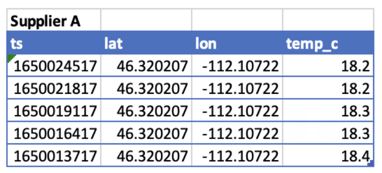Seamlessly Acquire Data from Numerous Sources with Rosetta Stone
by Brenna Dilger, on May 18, 2022
Every company collects and stores data differently, speaking their own data “language” that can be understood by internal systems, programs, and analysts. Since so many different “languages” are being used across the data ecosystem, it can be a time-consuming and labor-intensive process to decipher that data and translate it to be used outside of its original format. This has proven to be a major roadblock for efficient data transactions.
Narrative’s Rosetta Stone provides the solution to this challenge. Rosetta Stone translates data from many different languages into one universal language. It takes data in its native format from each provider and normalizes it so that all of the data from different sources can be combined and compared.
For instance, if three different data providers record dates as “mm/dd/yyyy,” “mm-dd-yyyy,” and “yyyy-mm-dd,” Rosetta Stone would identify all of the recorded dates as “date data” and normalize it into the same format. In this case, the data would be transformed into an output of “mm-dd-yyyy.”
Once Rosetta Stone does its job, the systems acquiring and ingesting the data won’t have to factor in infinite ways to express date and time data. They’ll be able to easily identify and read the data from every provider in one format. This makes it possible to acquire data from multiple providers in one dataset. It also shaves hours off of data ingestion times and gives data engineers back time to work on more important, value-generating tasks.
How does Rosetta Stone work?
To illustrate an example of Rosetta Stone in action, observe the weather data below. This data was collected by three suppliers that want to make their data available to buyers:



They all represent similar information, but they are stored in different formats. A buyer who wants to access this weather data, but who isn’t versed in the nuance of how the data is stored, is not going to be able to easily understand this data in order to apply it to their own missions and projects. That’s where Rosetta Stone comes into play.
Narrative CEO Nick Jordan says the best way to think of Rosetta Stone is as a “query planner.” Someone using the Narrative data collaboration platform can define the dataset that they need and Rosetta Stone will figure out how to fetch that data across suppliers, tables, and format.
For instance, a buyer can determine that they want timestamp, latitude, longitude, and air temperature data and the resulting dataset will be normalized across all of those fields.
Rosetta Stone can then create this combined output:

How do companies use Rosetta Stone on Narrative’s platform?
Rosetta Stone is the secret sauce that makes Narrative the #1 data collaboration platform in the world. It allows for buyers using Narrative to scale their data acquisition and buy lots of data from numerous suppliers at once. It breaks down barriers, opens new doors, and is blazing a new trail for the data economy.
With Rosetta Stone, a buyer just has to ask and they shall receive. Someone buying data can request the data they want and Rosetta Stone will find where that data resides, transform it, and normalize it. Rosetta Stone also keeps the provenance of the data attached to the record so that buyers know where their data is coming from. This ensures quality, precision, and transparency for all data acquirers.
Rosetta Stone makes buying precise third party data from numerous suppliers at once effortless. Data analysts and engineers often sink too much time into data cleansing and normalization across disparate datasets. The tedious task of cleaning and formatting any data you’ve acquired is taken care of for you on the backend. Data can be taken from several providers and delivered to a buyer’s preferred endpoint in a preferred format within hours.
As a data seller, you also won’t need to worry about transforming your data to be ingested by a potential buyer. You can upload all of your raw data into Narrative as it is natively stored. Rosetta Stone then makes it possible to combine datasets and create data products that will be instantly compatible with a buyer’s systems once they’ve ingested it.
Whether you are looking to buy data to improve internal operations and strategies, sell data to generate a brand new revenue stream, or share data internally across your organization, Narrative’s Rosetta Stone makes fast and seamless data transference a reality.
Narrative's Rosetta Stone makes buying and selling data easier than ever. Our experts can help you get started!


